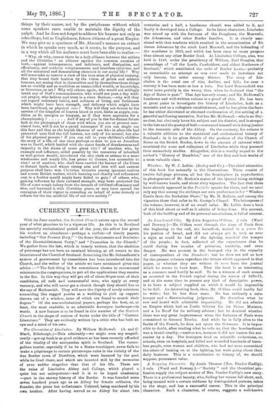The Chronicles of Lincluden. By William McDowell. (A. and C-
Black, Edinbargh.)—This admirably—we might even say magnifi- cently—got-up book is as good evidence as has been recently afforded of the vitality of the antiquarian spirit in Scotland. The cosmo- politan tourist, especially if he be a Burnsworshipper, never fails to make a pilgrimage to certain picturesque rains in the vicinity of the fine Border town of Dumfries, which were haunted by the poet while he lived there, and which are haunted still by the memories of even sadder tragedies than that of his life. These are the ruins of Lincladen Abbey and College, which played a quiet but not unimportant—and it is to be hoped chastening --part in the stormy history of the Border. It was founded some seven hundred years ago as an Abbey for female celibates, the founder, the pious but unfortunate ITchtred, being murdered by his own brother, After having served as an Abbey for about two
centuries and a half, a handsome chunk was added to it, and finally it developed into a College. In its latest character, Lincluden was mixed up with the fortunes of the Douglases, the Maxwells, the Johnatones, and other Border families. It is closely asso- ciated with that vendetta which resulted in the assassination of Sir James Johnstone by the ninth Lord Maxwell, and the beheading of the murderer in 1613, and which has been sung to more purpose than almost any other Border fend. It Lincluden College, also, was held in 1448, under the presidency of William, Earl Douglas, that assemblage of "all the Lords, Freeholders, and oldest Borderers of Scotland," which established the code of Border Laws,—probably as remarkable an attempt as was ever made to introduce not only honour, bat order among thieves. The story of Lin- :Kaden is the usual one of rise, decline, and fall ; for over a century it has been more or leas a ruin. But Lord Beaconsfield was never more prettily in the wrong than when he declared that "the Age of Ruins is past." That Age has only come ; and Mr. McDowall's handsome and well-written volume is a proof of this. He has been at great pains to investigate the history of Lincluden, both as a monastic and as a collegiate establishment, and he has given the facts he has either discovered or obtained confirmation of, the setting of a graceful and flowing narrative. Nor has Mr. McDowall—who is no Dry- as-dust, but obviously loves his subject and his district, and is steeped in the lore and the poetry of both—contented himself with doing justice to the romantic side of the Abbey. On the contrary, his volume is a valuable addition to the statistical and ecclesiastical history of Scotland ; in it he gives details of the position of the Church of Rome on the Scotch Border, down to the amount of oatmeal which nourished the nuns and collegians of Lincladen while they pursued their melancholy studies. Altogether, this is a worthy sequel to the author's "History of Dumfries," one of the fit-at and best works of a most valuable class.


































 Previous page
Previous page